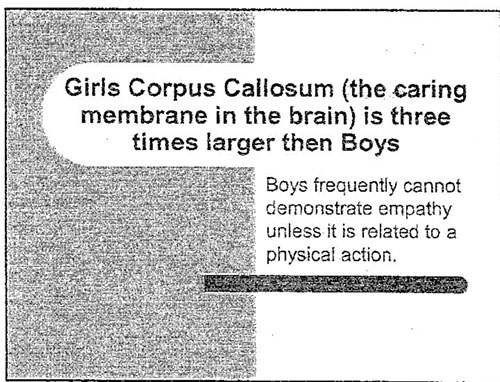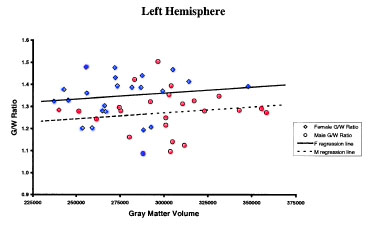October 05, 2007
The caring membrane in the brain
Heidi W., who originally told me about the crockus a few weeks ago, wrote recently that she obtained the handout from one of Dan Hodgin's recent presentations on discipline, and she sent along a scan of one of his slides:

Unlike the crockus, the corpus callosum does actually exist. Everything else on the slide is wrong -- and I'm not talking about the missing apostrophes and the misspelling of than. But I don't think that we have to track down the elusive Dr. Alfred Crockus in order to figure out where Mr. Hodgins got the inspiration for this latest neuro nonsense.
There are three assertions here:
- The corpus callosum is "the caring membrane in the brain".
- Girls' CC is three times larger than boys'.
- Boys frequently cannot demonstrate empathy unless it is related to a physical action.
Hodgins himself is a pathetic figure, worth debunking only as an example of the charlatanry that apparently can flourish these days in the demi-monde of pseudoscience that the education industry calls "professional development". But the seeds that grew into these false or misleading ideas are out there, and it's interesting to take a look at the process of re-interpretation, exaggeration and myth-formation that creates them.
In this case, we can start the debunking with Dan Hodgins' own prior work. In my original post on the Crockus, I quoted from an article that he published in the Mott Community College Focus a few years ago, "Male and Female Differences":
Another structural difference, and perhaps the most striking, is the corpus callosum, the bundle of nerves that connects emotion and cognition. In females, it is up to 20% larger than in males, giving females better decision making and sensory processing skills.
This 20% difference was imaginary to start with, so it's not surprising that in Hodgins' collection of powerpoints, it's grown to 300%. If you're going to make stuff up, and you're bold enough to invent a brain region called the "crockus", why not supersize your fabrications about brain regions that actually exist?
But Hodgins did not invent the idea that there might be a corpus-callosum difference that's somehow relevant to sex differences in empathy. We can find the seeds of this concept in Simon Baron-Cohen et al., "Sex Differences in the Brain: Implications for Explaining Autism", Science 310(5749):819-823, 2005.
Although there is a great deal of individual variance in human brain morphometry (21), it is known that the cerebrum as a whole is about 9% larger in men and is also larger in boys (21), a difference that is driven more by white matter than by gray (22, 23). Despite the larger total volume of white matter in men [and despite the conflicting studies of sex differences in specific corpus callosum measures (24)], three-dimensional (3D) morphometry suggests that the ratio of corpus callosum to total cerebral volume is actually smaller in men (22).
The corpus callosum is a bundle of several hundred million axons that make connections between the two hemispheres of the mammalian cortex. Describing it as "the caring membrane in the brain" seems at first like a bizarrely random choice of phrase, something like describing a car's intake manifold as "the braking cavity in the engine". But as we'll see, this is a misrepresentation and exaggeration of a controversial but respectable theory.
Those "conflicting studies" about sex differences in CC size -- SB-C's reference (24) -- are discussed in K.M. Bishop and D. Wahlsten, "Sex Differences in the Human Corpus Callosum: Myth or Reality?", Neuroscience & Biobehavioral Reviews, 21(5) 581-601, 1997, which I quoted a couple of months ago, and also in my original note on Hodgin's Crockus. They assert that "Data collected before 1910 from cadavers indicate that, on average, males have larger brains than females and that the average size of their corpus callosum is larger. A meta-analysis of 49 studies published since 1980 reveals no significant sex difference in the size or shape of the splenium of the corpus callosum, whether or not an appropriate adjustment is made for brain size using analysis of covariance or linear regression."
Bishop and Wahlsten thought it was appropriate to publish these negative results in order to correct some earlier work by Dr. Sandra Witelson, whose claims of a sex difference in corpus callosum size were the subject of many news reports and much speculation.
SB-C's reference (22), which he takes to trump Bishop and Wahlsten, is J. S. Allen, H. Damasio, T. J. Grabowski, J. Bruss, W. Zhang, "Sexual dimorphism and asymmetries in the gray-white composition of the human cerebrum", Neuroimage 18, 880 (2003). Let's accept that (22) is right and (24) is wrong -- what's the claimed sex difference in corpus callosum size?
Using high resolution MRI scans and automated tissue segmentation, gray and white matter (GM, WM) volumes of the frontal, temporal, parietal, and occipital lobes, cingulate gyrus, and insula were calculated. Subjects included 23 male and 23 female healthy, right-handed subjects. For all structures, male volumes were greater than female, but the gray/white (G/W) ratio was consistently higher across structures in women than men. Sexual dimorphism was greater for WM than GM: most of the G/W ratio sex differences can be attributed to variation in WM volume. The corpus callosum, although larger in men, is less sexually dimorphic than the WM as a whole.
(Roughly, gray matter is made up of the cell bodies of neurons, along with short-distance axons and dendrites, glial cells, capillaries and some other stuff; and white matter is made up of myelinated axons that interconnect neurons across longer distances.)
Here's the relevant table of results from Allen et al.:

In terms of percentages, the average male corpus callosum in this study was about 9% larger than the average female corpus callosum. On the other hand, relative to total brain volume, the average male corpus callosum was about 4% smaller. And relative to total white-matter volume, the average male corpus callosum was about 7% smaller.
It's not clear to me what to make of these differences absolute and relative volumes -- but none of them are anywhere near a difference of 20% larger in favor of women, much less "three times larger". (It's true that Hodgins is talking about girls vs. boys, not adults; for developmental details, if you care, see my earlier post.)
More important, these average differences emerge from distributions that are very highly overlapped. Allen et al. don't show the actual data points for the corpus callosum, but they do show scatter plots of individual's gray (or white) matter volume against the G/W ratio, for the left and right hemispheres separately. There are four of these scatter plots -- this is the one that shows the largest male-female difference:

(I've colored the female points blue and the male points red, since the quality of the figure as reproduced online makes it hard to distinguish them without scrutiny.)
OK, I hope you're saying to yourself, what does all this have to do with empathy, anyhow?
Continuing with Simon Baron-Cohen et al.'s 2005 Science article:
Recent hypotheses concerning neural connectivity in the autistic brain postulate an exaggerated version of what may also be going on in the typical male brain: a skewed balance between local and long-range connectivity (48–51). Such a connectivity difference could give rise to a deficit in empathizing, because empathy activates brain regions that integrate information from multiple neural sources (52). In autism, furthermore, long-range connectivity during an empathizing task is abnormally low (53). This notion of skewed connectivity is also compatible with strong systemizing, because systemizing involves a narrow attentional focus to local information, in order to understand each part of a system.
I described SB-C's theory of empathizing vs. systematizing in a post about a year ago, "Stereotypes and facts", 9/24/2006. Since then, several readers have taken me to task for being too credulous with respect to sex differences in empathizing that depend on self-report, as SB-C's data does.
Alen Murn sent me a reference to Nancy Eisenberg and Randy Lennon, "Sex Differences in Empathy and Related Capacities", Psychological Bulletin 94(1): 100-131, 1983. The abstract:
In this article, the literature on sex differences in empathy (defined as vicarious affective responding to the emotional state of another) and related capacities (affective role taking and decoding of nonverbal cues) was reviewed. [...] In general, sex differences in empathy were a function of the methods used to assess empathy. There was a large sex difference favoring women when the measure of empathy was self-report scales; moderate differences (favoring females) were found for reflexive crying and self-report measures in laboratory situations; and no sex differences were evident when the measure of empathy was either physiological or unobtrusive observations of nonverbal reactions to another's emotional state. Moreover, few sex differences were found for children's affective role taking and decoding abilities.
Murn also sent me Richard A. Fabes and Nancy Eisenberg, "Meta-Analyses of Age and Sex Differences in Children's and Adult's Prosocial Behavior", 1998, which surveyed "155 studies yielding 478 effect sizes", and came to essentially the same conclusions. Their interpretation of this pattern is that the apparent sex difference in empathy is probably a difference in social stereotypes and self-presentation, not a difference in actual feelings:
Sex differences in self- and other-reported prosocial behavior may reflect people's conceptions of what boys and girls are supposed to be like rather than how they actually behave. [...] These findings are consistent with the view that girls' reputations for prosocial behavior are greater than the actual sex difference. [...]
Findings in regard to sex differences in empathy and sympathy, like those for prosocial behavior, vary with the method used to assess empathy-related responding. As mentioned previously, Eisenberg and Lennon (1983; Lennon & Eisenberg, 1987a), in a meta-analytic review, found large differences favoring females for self-report measures of empathy, especially questionnaire indices. No gender differences were found when the measure of empathy was either physiological or unobtrusive observations of nonverbal behavior. In more recent work in which sympathy and personal distress were differentiated, investigators have obtained similar findings, although they occasionally have found weak sex differences in facial reactions (generally favoring females) (see Eisenberg, Martin, & Fabes, 1996; Eisenberg, Fabes,& Miller, et al., 1989). Eisenberg and Lennon suggested that the general pattern of results was due to differences among measures in the degree to which both the intent of the measure was obvious and people could control their responses. Sex differences were greatest when demand characteristics were high (i.e., it was clear what was being assessed) and individuals had conscious control over their responses (i.e., self-report indices were used); gender differences were virtually nonexistent when demand characteristics were subtle and study participants were unlikely to exercise much conscious control over their responding (i.e., physiological indices). Thus, when gender-related stereotypes are activated and people can easily control their responses, they may try to project a socially desirable image to others or to themselves.
Dan Hodgins, however, has a different interpretation:
Boys frequently cannot demonstrate empathy unless it is related to a physical action.
According to Fabes and Eisenberg's review, this might be true, if you interpret it to mean that boys and girls feel and act empathetically to the same extent, but girls describe themselves as more empathetic than boys do, because they've learned that it's expected of them. Somehow, though, I don't think that's how Hodgins meant the audience to interpret his bullet point.
Posted by Mark Liberman at October 5, 2007 06:32 AM